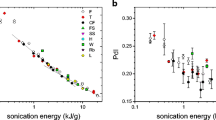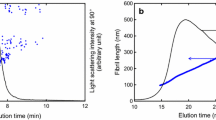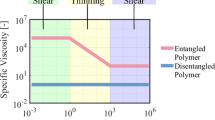Abstract
Cellulose nanocrystals (CNCs) derived from various types of cellulose biomass have significant potential for applications that take advantage of their availability from renewable natural resources and their high mechanical strength, biocompatibility and ease of modification. However, their high polydispersity and irregular rod-like shape present challenges for the quantitative dimensional determinations that are required for quality control of CNC production processes. Here we have fractionated a CNC certified reference material using a previously reported asymmetrical-flow field-flow fractionation (AF4) method and characterized selected fractions by atomic force microscopy (AFM) and transmission electron microscopy. This work was aimed at addressing discrepancies in length between fractionated and unfractionated CNC and obtaining less polydisperse samples with fewer aggregates to facilitate microscopy dimensional measurements. The results demonstrate that early fractions obtained from an analytical scale AF4 separation contain predominantly individual CNCs. The number of laterally aggregated “dimers” and clusters containing 3 or more particles increases with increasing fraction number. Size analysis of individual particles by AFM for the early fractions demonstrates that the measured CNC length increases with increasing fraction number, in good agreement with the rod length calculated from the AF4 multi-angle light scattering data. The ability to minimize aggregation and polydispersity for CNC samples has important implications for correlating data from different sizing methods.






Similar content being viewed by others
Notes
The identification of any commercial product or trade name does not imply endorsement or recommendation by the National Institute of Standards and Technology.
References
Bai W, Holberry J, Li K (2009) A technique for production of nanocrystalline cellulose with a narrow size distribution. Cellulose 16:455–465
Brinchi L, Cotana F, Fortunati E, Kenney JM (2013) Production of nanocrystalline cellulose from lignocellulosic biomass: technology and applications. Carbohy Polym 94:154–169
Brinkmann A, Chen M, Couillard M, Jakubek ZJ, Leng T, Johnston LJ (2016) Correlating cellulose nanocrystal particle size and surface area. Langmuir 32:6105–6114
Cherhal F, Cousin F, Capron I (2015) Influence of charge density and ionic strength on the aggregation process of cellulose nanocrystals in aqueous suspension, as revealed by small-angle neutron scattering. Langmuir 31:5596–5602
Dufresne A (2013) Nanocellulose: a new ageless bionanomaterial. Mater Today 16:220–227
Dufresne A (2019) Nanocellulose processing properties and potential applications. Curr For Rep 5:76–89
Eichhorn S (2011) Cellulose nanowhiskers: promising materials for advanced applications. Soft Matter 7:303–315
Foster EJ, Moon RJ, Agarwal UP, Bortner MJ, Bras J, Camarero-Espinosa S, Chen KJ, Clift MJD, Cranston ED, Eichhorn SJ, Fox DM, Hamad WY, Heux L, Jean B, Korey M, Nieh W, Ong KJ, Reid MS, Renneckar S, Roberts R, Shatkin JA, Simonsen J, Stinson-Bagby K, Wanasekara N, Youngblood J (2018) Current characterization methods for cellulose nanomaterials. Chem Soc Rev 47:2609–2679
Gigault J, Cho TJ, MacCuspie RI, Hackley VA (2013) Gold nanorod separation and characterization by asymmetric-flow field flow fractionation with UV–vis detection. Anal Bioanal Chem 405:1191–1202
Guan X, Cueto R, Russo P, Qi Y, Wu Q (2012) Asymmetric flow field-flow fractionation with multiangle light scattering detection for characterization of cellulose nanocrystals. Biomacromol 13:2671–2679
Hamad WY (2014) Development and properties of nanocrystalline cellulose. ACS Symp Ser 1067:301–321
Hirai A, Inui O, Horii F, Tsuji M (2009) Phase separation behavior in aqueous suspensions of bacterial cellulose nanocrystals prepared by sulfuric acid treatment. Langmuir 25:497–502
Hiraoki R, Tanaka R, Ono Y, Nakamura M, Isogai T, Saito T, Isogai A (2018) Determination of length distribution of TEMPO-oxidized cellulose nanofibrils by field-flow fractionation/multi-angle laser-light scattering analysis. Cellulose 25:1599–1606
Hu Y, Abidi N (2016) Distinct nematic self-assembling behavior caused by different size-unified cellulose nanocrystals via a multistage separation. Langmuir 32:9863–9872
Jakubek ZJ, Chen M, Couillard M, Leng T, Liu L, Zou S, Baxa U, Clogston JD, Hamad W, Johnston LJ (2018) Characterization challenges for a cellulose nanocrystal reference material: dispersion and particle size distributions. J Nanopart Res 20:98
Jorfi M, Foster EJ (2015) Recent advances in nanocellulose for biomedical applications. J Appl Polym Sci 2015:41719
Klemm D, Kramer F, Moritz S, Lindstrom T, Ankerfors M, Gray D, Dorris A (2011) Nanocelluloses: a new family of nature-based materials. Angew Chem Int Ed Engl 50:5438–5466
Mazloumi M, Johnston LJ, Jakubek ZJ (2018) Dispersion, stability and size measurements for cellulose nanocrystals by static multiple light scattering. Cellulose 25:5751–5768
Moon RJ, Martini A, Nairn J, Simonsen J, Youngblood J (2011) Cellulose nanomaterials review: structure, properties and nanocomposites. Chem Soc Rev 40:3941–3994
Mukherjee A, Hackley VA (2017) Separation and characterization of cellulose nanocrystals by multi-detector asymmetric flow field-flow fractionation. Analyst 143:731–740
Patel DK, Duttab SD, Lim K-Y (2019) Nanocellulose-based polymer hybrids and their emerging applications in biomedical engineering and water purification. RSC Adv 9:19143–19162
Postek MT, Moon RJ, Rudie AW, Bilodeau MA (eds) (2013) Production and applications of cellulose nanomaterials. TAPPI Press, Atlanta
Rasband WS (2018) ImageJ. US National Institutes of Health, Bethesda, Maryland, USA. https://imagej.nih.gov/ij/. Accessed 10 Dec 2018
Roman M (2015) Toxicity of cellulose nanocrystals: a review. Ind Biotechnol 11:25–33
Ruiz-Palomero C, Soriano ML, Valcarcel M (2017) Detection of nanocellulose in commercial products and its size characterization using asymmetric flow field-flow fractionation. Microchim Acta 184:1069–1076
Shatkin JA, Kim B (2015) Cellulose nanomaterials: life cycle risk assessment and environmental health and safety roadmap. Environ Sci Nano 2:477–499
Shatkin JA, Wegner TH, Bilek EM, Cowie J (2014) Market projections of cellulose nanomaterial-enabled products—part 1: applications. Tappi J 13:9–16
Taurozzi JS, Hackley VA, Wiesner MR (2011) Ultrasonic dispersion of nanoparticles for environmental, health and safety assessment–issues and recommendations. Nanotoxicology 5:711–729
Thomas B, Raj MC, Athira KB, Rubiyah MH, Joy J, Moores A, Drisko GL, Sanchez C (2018) Nanocellulose, a versatile green platform: from biosources to materials and their applications. Chem Rev 118:11575–11625
Trache D, Hussin MH, Haafiz MKM, Thakur VK (2017) Recent progress in cellulose nanocrystals: sources and production. Nanoscale 9:1763–1786
Uhlig M, Fall A, Wellert S, Lehmann M, Prévost S, Wågberg L, von Klitzing R, Nyström G (2016) Two-dimensional aggregation and semidilute ordering in cellulose nanocrystals. Langmuir 32:442–450
Wang D (2019) A critical review of cellulose-based nanomaterials for water purification in industrial processes. Cellulose 26:687–701
Acknowledgments
We thank Valerie Bartlett (NRC) for analysis of TEM images and Zygmunt Jakubek (NRC) for advice on use of a custom ImageJ macro for TEM image analysis. We thank Tae Joon Cho and Natalia Farkas (NIST) for helpful comments on the manuscript.
Author information
Authors and Affiliations
Corresponding author
Additional information
Publisher's Note
Springer Nature remains neutral with regard to jurisdictional claims in published maps and institutional affiliations.
Electronic supplementary material
Below is the link to the electronic supplementary material.
Rights and permissions
About this article
Cite this article
Chen, M., Parot, J., Mukherjee, A. et al. Characterization of size and aggregation for cellulose nanocrystal dispersions separated by asymmetrical-flow field-flow fractionation. Cellulose 27, 2015–2028 (2020). https://doi.org/10.1007/s10570-019-02909-9
Received:
Accepted:
Published:
Issue Date:
DOI: https://doi.org/10.1007/s10570-019-02909-9




